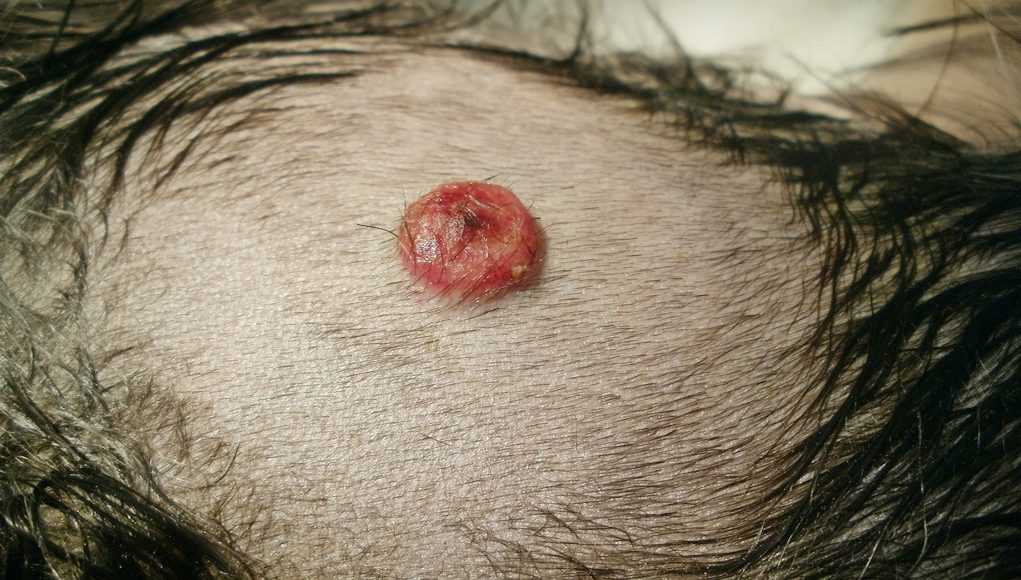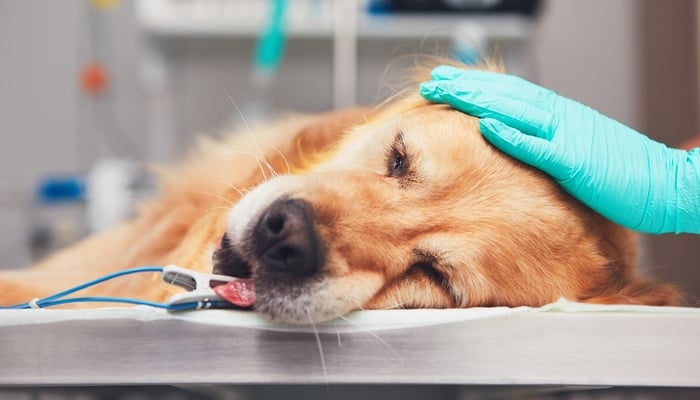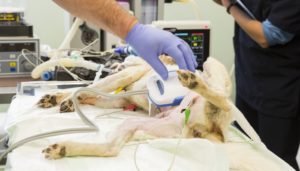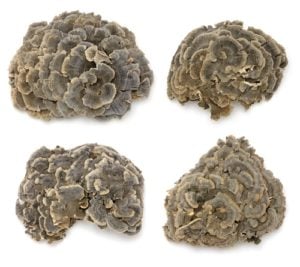Table of Contents
Not something many pet owners know about, but if you've just heard about hemangiosarcoma in dogs, your dog may have been diagnosed with a type of skin cancer that's extremely difficult to treat and is often fatal to dogs.
Here's everything you should know about this condition.
What is Canine Hemangiosarcoma (HSA)?
The lining of your dog's blood vessels is made up of cells called vascular endothelial cells.
A tumor that attacks the endothelium is called hemangiosarcoma.
Once within the blood vessel lining, it spreads throughout the blood vessels themselves.
Hemangiosarcoma in dogs is a cancer of the blood vessels that can occur either on the skin's surface or inside the body itself.
The skin variety can be surgically removed, and the chances of a full recovery are optimistic.
This type is often non-problematic, but that's different from what many pet owners encounter most commonly when they hear about canine hemangiosarcoma.
The internal form of hemangiosarcoma, however, is often fatal.
These tumors are malignant.
However, studies have observed successful treatment and recovery from canine HSA through chemotherapy and surgery that may extend the dog's lifespan (Wendelburg et al. 2015).
There is also a benign type of tumor called a hemangioma, closely related to how it formed.
Still, this type does not present a terminal outcome.
Hemangiosarcoma is aggressive cancer that frequently forms masses in the heart or spleen.
The tissue that makes up these cancerous masses is not as strong as normal tissue.
When they become filled with blood, they are likely to burst, causing sudden internal bleeding and death in dogs.
Here's everything you should know about it.
ALSO READ: 8 Cancer-Causing Dog Products (and how to avoid them)
Hemangiosarcoma in Dogs: Causes, Symptoms, Treatment
What Causes Hemangiosarcoma in Dogs?
As hemangiosarcoma is canine-specific cancer, there has not been as much research on this form of cancer as with those that can also afflict humans.
Within the veterinary world, this is one of those diseases that is a real mystery; we know what happens when your dog gets it, but we can't discover what makes it occur in the first place.
We do know that some breeds are more prone to it.
The fact that some breeds seem more prone to canine hemangiosarcoma leads us to believe that it has its roots in genetic predisposition.
Excess exposure to carcinogens and sunlight, especially in light-colored dogs, is also thought to contribute to HSA.
The breeds that are most affected by canine hemangiosarcoma are:
- German Shepherds
- Flat-Coated Retrievers
- Golden Retrievers
- Boxers
- Pit Bulls
- English Setters
- Portuguese Water Dogs
- Whippets
Any age or breed of dog can be afflicted.
Still, hemangiosarcoma in dogs is most commonly seen in the breeds mentioned above and in those over the age of six years.
The most common types of hemangiosarcoma in dogs are:
- Mesenchymal – the lymphatic and circulatory systems as well as connective tissue.
- Visceral – internal – the spleen, pericardium, heart, and liver.
- Dermal – of the skin
- Hypodermal – under the skin
Let's review the symptoms and causes of these four types.
What are the Symptoms?
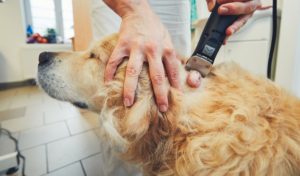
With Dermal hemangiosarcoma in dogs, problems can occur anywhere on the body.
Still, the most likely places are on the dog's abdomen, hind legs, and the prepuce.
There may be singular or multiple masses detected.
The masses may appear dark due to blood, and you may feel one or many small nodules that are raised, firm, and dark in color.
With Visceral, Mesenchymal, and Hypodermal hemangiosarcoma in dogs, it isn't easy to diagnose and is often diagnosed postmortem.
This is because it can suddenly and unexpectedly become a medical emergency.
The most common signs to look for with Visceral, Mesenchymal, and Hypodermal hemangiosarcoma in dogs are:
- lethargy
- pale gums (anemia)
- difficulty breathing
- collapse (in extreme cases)
Other signs to look for with this disease include:
1. Weakness
Your dog may present as having signs of weakness; it can even lead to collapse, resulting in partial paralysis or seizures.
2. Brain Function
Your dog may show signs of distress; when cancer attacks the brain, your dog does lose brain cells and will become upset, demonstrating confusion and nervousness.
Limping without apparent reason is also a potential sign that the brain is affected.
However, lameness can also be attributed to cancer attacking the bone.
3. Loss of Appetite
The dog who once would eat anything and everything may have gone off of his food. This happens when the body, trying to starve attacking cancer, causes the dog to lose his appetite.
4. Anemia
If the lining of his lips, ears, and nostrils appear paler than usual, that's a sure sign of anemia.
Anemia could be the result of your dog losing blood because of cancer.
5. Distended Abdomen
When you give your best friend a belly rub, have you noticed it feeling very full?
That might be a sign of an abdominal mass or abdominal fluid collecting there.
How is Hemangiosarcoma in Dogs Diagnosed?
This is a case where early detection through general checkups is the best way to extend your dog's chances of survival after detecting canine HSA.
Your veterinarian will form a picture of your dog's health by asking you questions, looking at the dog's history, and conducting a physical exam.
The veterinarian may also use the following techniques to examine your dog to help diagnose canine hemangiosarcoma:
1. Palpation – Skin cancer is usually detected by palpating a lump in the skin. Biopsies can determine the type of growth.
2. Abdominal Bloating – An examination of the belly will indicate if there is any swelling.
3. Radiographs (X-rays) – These can be used to help assess whether there is damage to the heart, liver, and spleen and if it has spread to the lungs.
4. Ultrasound – An ultrasound will be used to locate the mass and see if it is bleeding.
5. Lab Tests – Various lab tests can be done that will all help with the diagnosis.
6. Surgery – Ultimately, this will be needed to remove a tumor so that a biopsy can be conducted to confirm that it is hemangiosarcoma and not another type of growth.
Managing Symptoms Yourself (Holistic Way)
If you know your pet has canine hemangiosarcoma, you have already discussed the treatments available with your veterinary surgeon and know the facts.
If your dog has had surgery to remove the tumor, you may feel as if you're sitting with a ticking time bomb; if your dog hasn't had the surgery, you will feel the same.
Some pet owners prefer to be referred to a holistic vet.
While there is no known cure, a variety of alternative treatments are available to help your dog.
However, there needs to be more scientific evidence to prove they actually work to be conclusive.
One of the most commonly used alternative treatments for hemangiosarcoma in dogs is the Coriolus Versicolor mushroom.
Also known as the Yunzhi mushroom or the Turkey-tail mushroom, it has been used in traditional Chinese medicine for over 2,000 years.
Much research has been done on a compound found within the mushroom, polysaccharopeptide, or PSP, which has been shown to have cancer-fighting properties.
In 2012 there was a small study on the benefits of the Yunzhi mushroom for dogs suffering from cancer (Brown et al. 2012).
The study delivered promising results.
It is still not a cure for cancer.
However, it looks like a potentially cheaper alternative to chemo with fewer side effects, extending a dog's life by a significant margin.
Although, the study sample and design weren't perfect, and further evidence is needed.
There were also attempts to use minocycline, tetracycline antibiotic.
Minocycline fights bacteria and is often used for various severe skin conditions.
However, new studies show that this drug is ineffective for hemangiosarcoma in dogs.
In 2000, a study with 18 dogs compared treatments with and without minocycline.
It concluded absolutely no difference in each case, suggesting that minocycline is ineffective for this type of cancer in dogs (Sorenmo et al. 2000).
As with all treatment of your dog, especially of this nature, you are advised to consult your vet before embarking on an alternative route.
Only your vet will know the interplay between what she is prescribing and what you plan to use as a supplement.
MORE: 4 Bee Products That Can Improve Your Dog's Health (Based On Science)
Treatments for Canine Hemangiosarcoma
The dermal variety of this condition is operable with good chances of success.
Sadly, there are no known cures for visceral canine HSA.
Your veterinarian will help you make the best choice for your dog.
The three most common treatments for canine hemangiosarcoma that have some chance of success and increasing a dog's survival are:
1. Surgery
This will be carried out to remove the affected tissues. In many cases, the entire organ will have to be removed, meaning it will frequently be the whole spleen or a section of the liver.
During the operation, the vets will examine the dog's entire abdomen.
After surgery, samples taken will be sent for analysis. This is a major surgery, and your dog will have to be monitored for up to two days post-surgery.
In 2015, a study with 208 dogs compared the survival times of treating splenic hemangiosarcoma in dogs through chemotherapy alone versus surgery combined with two types of chemotherapy, the doxorubicin and the cyclophosphamide protocols (Wendelburg et al. 2015).
The results show that surgery helps prolong the dog's life and increase the survival rate.
2. Chemotherapy (with doxorubicin)
We know this is not a cure for this type of cancer.
Still, combined with surgery, this can extend your dog's life by up to a year by combating cancer cells that have spread throughout the body.
Even if the cancer is too advanced for surgery, chemotherapy can be used to good effect, reducing its severity and alleviating some of the symptoms.
Research has continuously tested new types of related treatments like novelty delivery systems – inhalation or intracavitary chemotherapy (Clifford et al. 2000).
However, the results are still mixed.
The researchers seek something more effective than the proven surgery and chemotherapy combinations.
3. Radiotherapy
Radiotherapy or radiation therapy treatment (RT) is not used very often.
However, it can be beneficially used in conjunction with chemotherapy, in reducing pain and even prolong survival times.
On average, dogs have been known to survive three-to-six months post-surgery in cases involving an organ.
If the spleen is involved and hasn't ruptured, the post-surgery outcome is slightly better.
Some scientific literature is available on the effectiveness of radiotherapy for dogs with hemangiosarcoma.
In 2007, a small study of 20 dogs showed positive effects of RT on canine HSA (Hillers et al. 2007).
Then a more recent pilot study with six dogs showed that RT indeed can provide clinical benefits for dogs with HSA (Nolan et al. 2017).
In addition, radiotherapy was also shown to increase survival times in dogs with other types of cancers, like brain masses and other advanced cancers.
If there is no visible spread of cancer during surgery, the patient follows up with chemotherapy and implements any dietary and environmental changes recommended by the vet; the survival time can be up to a year, in exceptional cases, a little more.
MORE: 3 Dog Food Diets To Prevent Diseases (Based On Science)
What Should You Do?
If the disease is discovered later, the survival chances are minimal.
Whether or not you choose to put your dog on the operating table, there are things you can do to make your pet's life more comfortable after diagnosing HSA.
If the disease is discovered early and diagnosed thanks to a biopsy, you know that surgery is your best bet, but it will not cure the disease.
All it can do is buy you a few precious extra months with your four-legged friend.
With visible symptoms and a diagnosis from your vet, the survival time is a few short weeks or maybe less.
Once your dog has had surgery, he will need to rest; this is major surgery.
A cone collar will keep your pup from injuring the surgery site.
Antibiotics and painkillers will usually be administered for at least a week.
And a change of diet may be recommended.
If your dog is not a candidate for surgery, euthanasia should be considered.
To save your dog from the pain and distress of internal bleeding and collapse, it is sometimes better to make the heartbreaking decision to put him to sleep.
This is the kind of case that vets hate.
The dog shows up at their office, looking perfectly well, but we know the underlying problem will not go away.
Sometimes, as heartbreaking as it is, euthanasia is the kindest thing to do for your pup.
Hemangiosarcoma FAQs
Can you prevent hemangiosarcoma in dogs?
No. Sadly, there isn't anything specifically out there known to prevent internal hemangiosarcoma.
However, hemangiosarcoma that grows on the skin is preventable if you work on avoiding UV radiation on your pups bare skin.
What percentage of dogs get hemangiosarcoma?
Fortunately, hemangiosarcoma is not super common.
About 5% of dogs end up being diagnosed with hemangiosarcoma.
Final Thoughts
A diagnosis of hemangiosarcoma in dogs is almost always fatal.
The surgery increases your dog's survival time, especially when combined with chemotherapy (and potentially radiation therapy).
Whatever treatment you and your veterinarian decide on, now is the time to enjoy your remaining time with your dog if they have been diagnosed with canine hemangiosarcoma.
He might be ill but he can still feel the love you have for him, and if he's well enough, enjoy those last walks in the park, down near the river or mini road trips.
READ NEXT: Bone Cancer In Dogs – What It Means for Your Dog and What To Do


